|
|
|
Published
on 27
Feb 2010
|
All rights reserved.
|
|
|
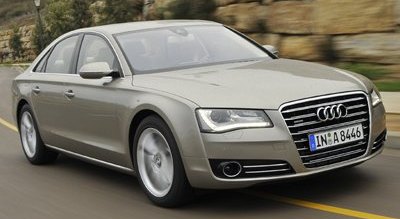
|
Today's A8 is a mix of art, technology
and quality, a showcase of the best bits of the Volkswagen empire...
|
22
years ago, Audi built
its first ever V8 engine from a pair of Volkswagen 1.8-liter engines.
It put the engine into a stretched Audi 100/200 platform to form its
first generation luxury car, V8 Quattro. Predictably, few people were
impressed by such a small-budget development. Even fewer saw it as a
comparable alternative to BMW, Mercedes and Jaguar, especially when
brand image was taken into account. However, V8 Quattro showed the way
to go. Since then Audi started migrating to a true premium brand.
How time has changed. Today, Audi becomes the most formidable rival to
BMW and Mercedes. No one see it as a second-division player again,
thanks to its full range of quality saloons, wagons, hatchbacks,
crossovers and sports cars. Today's A8 is a mix of art, technology and
quality, a showcase of the best bits of the Volkswagen empire. Its
styling is tastefully done. Its cabin is impeccably built, better than
that of Mercedes and BMW and only lacks the exclusivity of Bentley and
Rolls-Royce. It offers any sophisticated safety equipments you can
dream of: night vision infrared camera, pedestrian recognition, speed
sign recognition, pre-crash safety system, adaptive cruise control,
lane departure warning, blindspot warning... In the mechanical side, it
is equally impressive. Since the first generation A8, it has been
employing aluminum spaceframe chassis and permanent all-wheel drive
system. Its suspension has adaptive air springs and dampers. Its "Audi
Select Drive" system offers 4 modes for you to alter suspension,
throttle, gearshift and steering mapping. In short, it is a technical
tour de force.
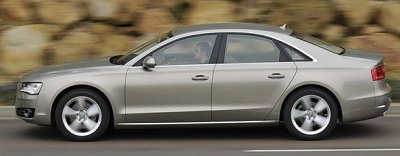
|
In short, it is a technical tour de
force.
|
Compare to the last generation, the
Mk3 car introduces plenty of improvements. First of all, its ASF
chassis is 25 percent stiffer than before thanks to the use of 13
different grades of aluminum alloy instead of the previous 5. The
B-pillars are now made of steel to better deal with side impact. Like
other members of the ML platform, its clutch has been moved to the back
of front axle in order to make its nose a little bit lighter, if not
really light. To reduce its inherent understeer, the new Quattro system
now sends 60 percent power to the rear wheels, and a torque-vectoring
active rear differential is now available as option. Further help comes
from a new active steering, whose gear ratio is variable according to
speed, angle and driving mode. The aforementioned Audi Select Drive
system is also new to the Mk3.
In the powertrain side, all engines get increased power yet reduced
fuel consumption. Horsepower of the 4.2 FSI V8 is pumped up from 350 to
372, thanks to reduced friction in chain drive and auxiliaries. The
3.0-liter turbo diesel V6 gets another 10 horses to a total of 250,
along with 406 pound-foot of torque. However, the fastest engine at
launch is 4.2 TDI V8, now produces 350 horsepower and an astonishing
590 pound-foot of torque from just 1750 rpm to achieve 0-60 mph in 5.2
seconds. Fuel consumption is reduced by an average 15 percent across
the range, 6 percent of which is down to the new 8-speed automatic
transmission by ZF.
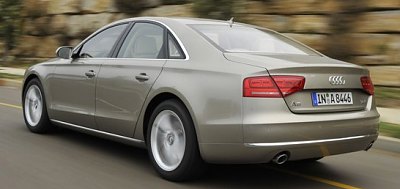 |
Fuel consumption is reduced by an
average 15 percent across the range...
|
The suspensions are basically the same
as the last one, i.e. a 5-link setup up front and a trapezoidal 4-link
setup at the rear, all with aluminum control arms. However, to help
easing the firm ride of the previous A8, it employs the latest
dual-cast brake discs, whose aluminum hubs save 3.75 kg of unsprung
weight each corner.
The bodyshell of Mk3 gets smoother, with aerodynamic drag reduced from
the already remarkable 0.27 to 0.26, matching that of the class-leading
Lexus LS. It also gets larger - some 86 mm longer, 55 mm wider, 16 mm
taller and its wheelbase is 48 mm longer - now it is actually bigger
than Mercedes S-class and BMW 7-series. Kerb weight has been increased
by a fair 55 kg. As much of the aluminum advantage is offset by its
compulsory 4-wheel drive hardware, an A8 4.2 FSI is only 45 kilograms
lighter than Mercedes S500, despite of its smaller engine. A 5-liter
Jaguar XJ, also with aluminum chassis but without the burden of 4WD, is
80 kg lighter. We shall see what it means to performance...
Close Encounter
First impression of the car isn't as convincing as its technical
specifications suggested. This is because of its exterior design. While
the A8 is still a stylish design, it looks fatter (it is !) and less
tasteful than before. Its ever more prominent single-frame grille and
angry eyes (now fully made of LEDs) try too hard to tell you its
identity, compromising the understated elegance of the previous model.
The new A8 also looks far more ordinary than I expected. Basically, it
appears to be an enlarged A4 rather than a bespoke luxury car in the
same way as BMW 7er and Mercedes S.
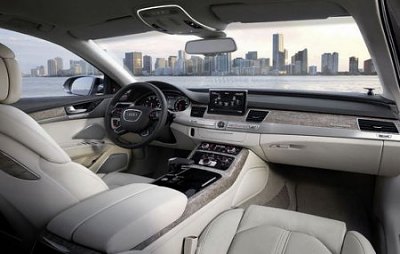
|
You swear that no one in the
mainstream luxury segment could produce a better cabin...
|
This is, of course, a false
impression. Once you have sat into the car, all the presumption is
washed away by its expensive materials and elegant finishing. You swear
that no one in the mainstream luxury segment could produce a better
cabin. Like 7-Series, its design is simple and intuitive, but its
materials are more tightly assembled, which means the gaps are
remarkably narrow and the surfaces are smooth and even. There are also
plenty of elegant details, such as the gear lever which might just
happen in a multi-million-dollar yacht. The MMI multimedia control now
includes a touchpad for writing with your finger. The only small
disappointment is the lack of a full TFT LCD instrument panel like
Mercedes and Jaguar, but its traditional gauges are easy to read.
Given the extra exterior size, it is a little disappointing to find the
cabin not as big as those of Mercedes and BMW. Although it has enough
head and leg room for six-foot-plus passengers, it does not deliver the
sense of excessive space normally required by the
customers of this class.
On the Road
Guide the A8 on highway, you will discover a new found level of
refinement in the well insulated cabin. Wind noise is remarkable only
for its absence. Tire roar is very well suppressed. Ride quality is as
composed as its best rivals, at least on smooth motorway. Undoubtedly,
the slippery shape, double-glazing windows and improved suspension
plays an important role here.
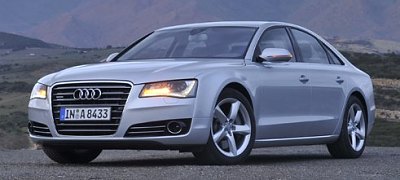
|
If you regularly drive on roads as
smooth as Germany or Japan's, you will be difficult to find a better
car than this...
|
All three
engines are up to the job. The entry-level 3.0 TDI has broad spread of
torque to overtake slower cars with no more than a small prod of
throttle. A touch more refinement might help it to match the
six-cylinder diesel engines of BMW, Mercedes or Jaguar. It is by no
means harsh, just not as rounded as its excellent rivals. The V8 diesel
is better. Not only hugely powerful, it is very smooth and quiet. No
doubt it is the best of the bunch, and the best big diesel engine in
the class. This make the petrol V8 a little unappealing. With a much
weaker torque delivery, it does not propel the A8 as strong as the 4.2
TDI, nor could it match the larger V8 of Mercedes or the twin-turbo V8
of BMW. Why didn't Audi enlarge it ? Because its 84.5 mm bore is
already the maximum allowed by the 90 mm bore center spacing, which is
shared with all Volkswagen group modular V6s and V8s. Its 92.8 mm
stroke is also the longest possible. Why didn't turbocharge it ?
Perhaps Audi wants to save it for the forthcoming S8, which is rumoured
to replace the existing V10 with a twin-turbo V8. Anyway, the 4.2 FSI
is not slow - nothing capable of doing 0-60 mph in 5.4 seconds could be
called slow. It just shows how much its rivals have progressed.
Guide the car to mountain roads and push through a series of bend, you
will find its ride and handling character depends very much on the
setting of Audi Select Drive. Set it at "Comfort", it rides soft to the
extent that doesn't feel connected to the road. The steering is light
and relatively slow. Body control is average. Change to "Dynamic" mode,
the steering becomes weighty and its response more direct, though the
feel is still artificial. Stiffer suspension leads to excellent body
control, but ride quality suffers. On coarse surfaces, the A8 rides
harsher and noisier than most other luxury cars, a sharp contrast to
its composure on highway. This is probably due to a firmer suspension
calibration that is necessary to contain its nose-heaviness. Quattro
system has its pros and cons. You might praise its extra security in
poor weather, but for most of the time it hampers steering feel and
ride quality. Is it worthwhile ? Nose-heaviness is another by-product
of Quattro. Although the new A8 hides it very well in normal driving,
it is still exposed to the driver in the form of understeer when the
car is pushed to the limit of adhesion. A rear-drive rival just won't
understeer so much.
The A8 is not without its charm. If you regularly drive on roads as
smooth as Germany's or Japan's, choose the long-wheelbase A8L with 4.2
TDI engine, you will be difficult to find a better car than this.
However, all things considered, the Audi flagship is not yet good
enough to challenge for the top of the class, although it is much
closer than V8 Quattro did 22 years ago.
|
Verdict:     |
Published
on 8
Aug 2010
|
All rights reserved.
|
|
| A8 W12
|
|
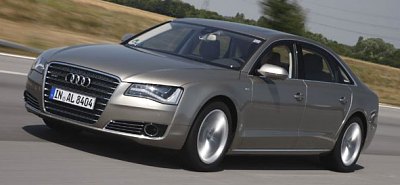
|
Slightly less powerful than rivals, A8
W12 still returns more than brisk performance.
|
Just
as the last two
generations, the new A8L W12 is the luxury flagship of Audi. It
occupies a very exclusive market segment together with Mercedes S600
and BMW 760Li. Price is some 40 percent higher than A8 4.2 V8. In
return, you get a 12-cylinder engine, a longer wheelbase and more back
seat luxury features. Every year only a couple of thousands wealthy
customers will opt for this model.
As before, the W12 engine is a technical tour de force. It achieves a
really compact size by packing 12 cylinders in 4 rows. You may see it
as a pair of Volkswagen narrow-angle (15-degree) V6 engines mated at 72
degrees. Only 4 camshafts are used to operate 4 valves per cylinder,
all are served with infinitely variable intake and exhaust valve
timing. It is amazing how the engineers could put so many things into a
space so small. If not the existence of W12, I suppose Audi A8 would
not have been possible to accommodate a 12-cylinder engine in front of
its front transaxle.
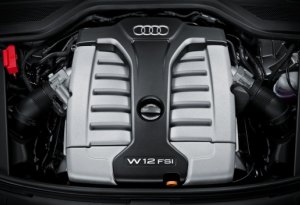
|
Dull-looking engine
|
Although rival BMW has switched to turbocharging in its new V12 engine,
Audi keeps its unique W12 engine in naturally aspirated form. However,
displacement has been enlarged slightly, from 5998 cc to 6301 cc,
thanks to a larger bore (86mm instead of 84mm) and marginally longer
stroke (90.4mm instead of 90.2mm). The addition of FSI direct injection
allows compression ratio to be raised from 11.0:1 to 11.8:1. As result,
output increases by 50 horsepower to a neat 500hp. Besides, the new
engine also drinks less fuel. Thanks to the direct injection, reduction
of friction from crankshaft and timing chains and upgrading to 8-speed
ZF transmission, Audi said its fuel consumption has been reduced by 12
percent, making it slightly greener than 760Li and S600.
What it can't quite match its rivals
is torque, which is
predictable from its lack of turbocharging. The W12 produces 461
pound-foot at a rather high 4750 rpm, whereas 760Li pumps out 553 lb-ft
from 1500-5000 rpm. This means on the road it lacks the sensational
g-force once you bottom the gas pedal from very low speed. However, the
A8 W12 still feels more than brisk, as are any machines possessing 500
horsepower and a quick-reacting 8-speed automatic. Its slightly lighter
weight (120kg less than BMW, for example) also helps. This is confirmed
by the 0-60 acceleration figure of 4.6 seconds (4.4 sec for BMW).
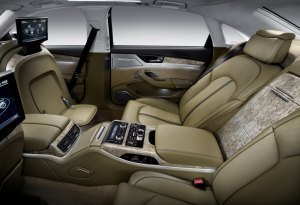 |
Luxury cabin |
As expected, the W12 is silky smooth throughout the rev
range. It spins
with near silence until you provoke it, when it emits an enthusiastic
roar. The ZF gearbox shifts seamlessly, and responds quickly to your
input at manual mode. It does all the clever things you wish: hold
gears, rev-match... just like in the case of BMW which shares the same
gearbox. The only disappointment is, when you want to see all these
fine mechanicals by opening the bonnet, what faces you is a large
plastic cover trying but failing to resemble the real engine. Modern
insulation robs us of the chance to connect to the machine.
Perhaps the owners of this car are not interested in oily bits, neither
do they care how the car feels to drive. They are likely to spend their
precious time at the luxurious back seat. Instead of the bench seats in
lesser A8s, the W12 has two individual tycoon seats, which have power
reclining, heating, cooling and massaging. They also get individual
infotainment and climate system, folding tables, a refrigerator and
even foot rests in the expense of front seats. Such equipment
approaches the level of Bentley, Rolls-Royce and Maybach, although the
Audi does not have the sense of occasion in its cabin design and
materials. Potential buyers may also dislike its exterior styling,
which is too much like other mainstream Audis. |
Verdict:    |
Published
on 9
Nov 2011
|
All rights reserved.
|
|
| Audi S8
|
|
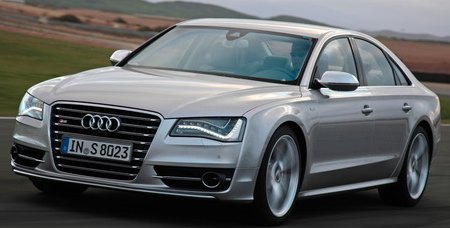
Downsized
turbocharged engines have become an inevitable trend of motor industry,
as I have pointed out many times in AutoZine. New EU legislation
EC443/2009 calls for very stringent carbon-dioxide emission targets.
Car makers failing to meet these targets will have to pay heavy penalty
for every gram of CO2 per kilometer
exceeded. In the USA, tightened CAFE standards also stress manufacturer
to lower fleet emission average or face heavy charges. As a result, the
only way to lower emission dramatically while maintaining performance
will be to use downsized turbocharged engines. Recently, we saw
Mercedes and BMW did very well in this respect, producing far greener
yet more powerful motors to keep their loyal customers happy. Now Audi
also joins the trend with its new S8. Instead of the old car's
monstrous 5.2-liter V10 is an all-new 4.0-liter twin-turbo V8. It will
be used in S6, S7 and Bentley Continental GT as well, so it will be
very crucial to the future of Volkswagen group's luxury cars.
Like its German rivals, the new V8 cuts fuel consumption considerably
(23 percent) compared to the outgoing V10. It also delivers very
respectable output – some 520 horsepower or 130 hp per liter. The
former is 70 horses up from the old engine. Torque delivery is also
vastly improved, with 479 lbft delivered between 1700 and 5500 rpm,
versus the old engine's 398 lbft at 3500 rpm. No matter the high
specific output or the wide spread of torque, this engine closely
matches that powering the new BMW M5.
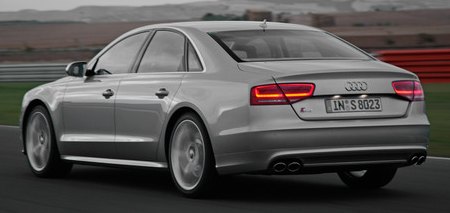
In fact, the Audi V8 has copied one of the BMW's ideas that made it so
good: cross-bank turbocharging.
Its two turbos, together with exhaust ports, are unusually located
inside the Vee so to ensure short piping, constant blowing to the
turbines and the compatibility with twin-scroll turbos (to reduce
exhaust gas interferences). The principle is quite complicated. If you
are interested, you may read our Technical
School for full explanation. What we need to know here is the end
result: quicker low-end response and reduced turbo lag. No wonder the
engine delivers high specific output yet a maximum torque from just
1700 rpm.
Strangely, Audi did not mention too much about the cross-bank
turbocharging despite of its significance – perhaps to avoid being
called copycat. Instead, it spent most marketing power on the green
technology of the engine, including automatic stop-start, brake energy
regeneration and in particular the new cylinder deactivation system
which turns the V8 effectively into a V4 under light load. Cylinder
deactivation is not exactly a new technology, as GM, Mercedes, Chrysler
and Honda have been using it for years. Anyway, Audi's mechanism is
unique because it is adapted from its Valvelift system. By switching
the cam sleeves on cylinder 2, 3, 5 and 8 to zero lift cam lobes and
disabling the corresponding fuel injection and ignition, it shuts down
those cylinders and save fuel. This contributes to a reduction of 5.5
percent in European combined cycle, or as much as 9 percent at 75 mph
steady cruise.
To deal with the second order vibration resulting from the 4-cylinder
mode, the S8 introduces active engine mounts. It detects the vibration
and uses an electromagnetic actuator to generate out-of-phase
counter-oscillations to the hydraulic fluid in the mounting, therefore
cancelling the vibration. What about the unpleasant noise in the
4-cylinder mode? The answer is active noise control (ANC). It is also
hardly a new technology (see the 2002 Honda Inspire or
the current Infiniti M), although its usage is still rare. 4
microphones detect the engine noise in the cabin and produce an
opposite-phase sound through the speakers to cancel the noise.
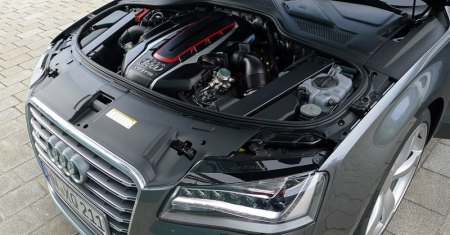
In the real world, these technologies work fabulously. The new engine
remains smooth and quiet in V4 mode. The transition from eight to four
cylinders is barely perceivable if you really pay attention. This means
most drivers are unlikely to notice. Fire all cylinders, the engine
responds quickly to throttle with hardly any turbo lag. The power
delivery is linear and seamless. It feels slightly smoother than the
BMW V8, but in terms of raw punch it feels less dramatic than AMG's
biturbo V8. After all, the latter delivers nearly 200 pound-foot more
mid-range torque ! The same story goes for aural quality. While the
Audi V8 produces delicious rumbles, it is always quieter and more
cultured, failing to strike your soul like the AMG full-bore thunder.
Perhaps because of the understated sound and the seamless operation of
its ZF 8-speed automatic, the S8 doesn't feel as quick as a big car
capable of 0-60 in 4.1 seconds. This lack of drama robs it of the
driving thrills that we expect from a rival to S63 AMG, XJ Super Sport
or Panamera Turbo. We are also a bit disappointed with its regulated
top speed of 155 mph, which makes it hard to keep up with the AMG and
Porsche on Autobahn.
Engine aside, revisions to the car is fairly subtle. The ZF
transmission gets a slightly sportier shift pattern. The adaptive air
suspension is lowered by only 10 mm, and the springing and damping are
reprogrammed to be slightly stiffer in each of the Audi Select Drive
mode. These alternations are just as subtle as the exterior facelift,
which needs those larger (20 or optional 21-inch) wheels and S8 badge
to distinguish from lesser A8s. Inside, the cabin is virtually
unchanged.
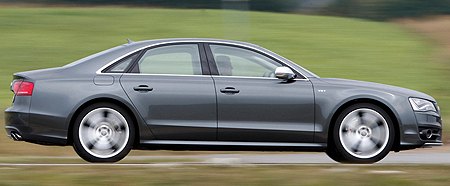
From a keen driver's point of view, the S8 is not as interesting to
drive as the aforementioned rivals as well as the slow but highly
entertaining Maserati Quattroporte. Undoubtedly, it is fast and highly
capable in real-world conditions, thanks to the superb powertrain,
four-wheel traction and sophisticated electronics. To certain extent,
its 40:60-split Quattro and active rear differential (what Audi called
"Sports Differential") have cured most of its nose heaviness, resulting
in more accurate and agile handling. Nevertheless, the artificial
correction is not always presence. Give it a tight corner and you will
find the S8 displays a moderate level of initial understeer before its
active rear differential starts working, by then the sense of agility
is already hurt. As a result, the car feels every bit of its 2-ton
weight on narrow and unpredictable country roads. Its handling needs
fast and smooth roads to exploit. Coupling to the fact that the
suspension still biases towards the firm side, we can say the Audi
remains a typical German highway rocket.
Agility aside, the car also fails to engage its driver with its
interfaces. The speed-sensitive steering might be heavier than that on
the regular A8, but it feels just as artificial. Switch to Dynamic mode
adds only more weight without any more feel. Together with the subdued
engine noise and effective sound insulation, the S8 feels rather cold.
Moreover, the uncanny smooth automatic transmission also lacks the
sparkles expected on a high performance car. While it works perfectly
in automatic mode or manual upshifts, manual downshifts after heavy
braking is not reacted with enough throttle blip to match rev, so it
takes longer to recover from every slow corner. Such behavior can
hardly engage its driver.
The problem of the new S8 does not lie on its new twin-turbo V8. On the
contrary, it is the lack of changes beside the new engine. The result
is just a faster version of A8, not a more entertaining one. |
Verdict:    |
| Published
on 4
Apr 2012 |
All rights reserved.
|
|
| A8 Hybrid |
|
25
years ago, seeing a Mercedes-Benz 280SE struggling uphill, I thought a
2.8-liter six-cylinder was probably the smallest engine a large luxury
car could ever employ. That forecast was proved to be correct in the
next quarter century as cars and their engines grew in size gradually.
However, the trend took a sudden U-turn recently. The awareness of
global warming drove drastic change of government policies regulating
the car industry. Low carbon emission becomes the norm. To realize the
aggressive targets of emission reduction, car makers have to apply
whatever they learnt – downsizing, weight reduction, low drag and
friction, hybrids, EVs… Consequently, for the first time ever Mercedes
equipped its S-class with a four-cylinder engine to make the S250CDI.
It returns a remarkable 49.5 mpg and emits only 149 grams of CO2
per kilometer. Such figures would be decent for a Volkswagen Golf a few
years back!
Now Audi is joining Mercedes to offer a four-cylinder engine in its
luxury limousine. In fact, it goes a step further. The A8 Hybrid
combines a 211 hp 2.0 TFSI Valvelift engine with a 54 hp electric
motor. The disc-shape motor is housed inside the casing of the 8-speed
Tiptronic gearbox, sandwiched between the engine and the gear sets in
place of torque converter. A clutch pack is responsible for the
engagement and disengagement of the motor and engine. Provided the
1.3kWh lithium-ion battery is full, the total system output is 245 hp
and 354 lbft, sufficient for the car to go from 0-60 mph in a
reasonable 7.3 seconds and reach a terminal velocity of 146 mph on
Autobahn. While its fuel economy of 44.8 mpg is not as good as the
S250CDI (remark: diesel and gasoline are not directly comparable), its
emission beats the Mercedes at 147 g/km. That last figure is the most
important to our planet.
Predictably, the small electric motor and battery pack do not allow a
broad usage of EV mode, which lasts no more than 3 km (1.8 miles) and
runs at a speed no higher than 62 mph. The latter might be deceiving,
as it takes the petrol engine to accelerate to that speed, then shuts
down the engine and coasts with the help of electric power alone.
Anyway, the integration of the hybrid system is good. Transition
between petrol and electric propulsion is almost seamless, as you can
expect for a German engineered product. The unpleasant 4-cylinder noise
can also be largely cancelled by the Active Noise Control system, which
produces counter-phase sound by the speakers.
That said, I suspect few A8 buyers would opt for the Hybrid model.
Lexus was successful to launch its LS600h hybrid because that car
combines a green image with the status of performance flagship. In
contrast, the A8 Hybrid is the slowest model in its family and the only
one driven by front wheels. The title of the world's greenest luxury
limousine alone is not enough to satisfy the desire of rich buyers. |
Verdict:    |
| Published
on 9
Dec
2015 |
All rights reserved.
|
|
| Audi S8
Plus |
|
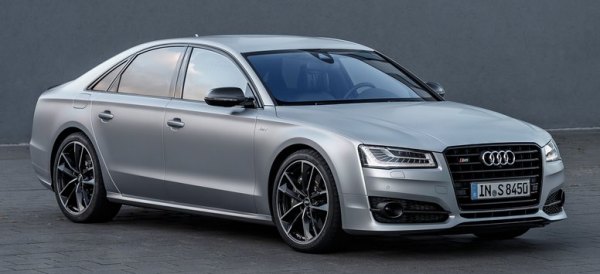
|
A 605-horsepower limousine
should have been headline news, but now we have seen a 707 hp Dodge
Charger, 691 hp Tesla and 640 hp Cadillac CTS-V, perhaps 605 hp is not
too much. However, when you know Audi managed to squeeze 605 hp out of
a 4-liter V8, it is still worth applause. The S8 Plus is not radically
different from the existing S8, but it is a testament that the S8 has
plenty of potential for upgrade. The biturbo V8 needs only a re-mapped
ECU, which increases boost pressure and extend the rev limiter by 200
rpm, and a few minor modifications to liberate another 85 horsepower.
Peak torque now reaches 553 lbft on overboost, which is also the limit
of the 8-speed Tiptronic automatic. Although the car is by no means a
lightweight at exactly 2 tons, with the help of Quattro traction it is
capable of standing start to 60 mph in a blistering 3.7 seconds. Should
you opt for the Dynamic pack (as nearly every buyer does), its top
speed will be extended to 190 mph. If it were allowed to de-restrict,
it would have been good for 200 mph. So fast that it needs to fit
ceramic brakes as standard.
Fast though it is, the S8 Plus is no more engaging to drive than the
S8. Its air suspension is re-programmed to be stiffer in all modes but
Comfort. This means less roll in fast corners, but the suspension and
steering still fail to relay more information into your hands and seat
of the pants. The sound of the V8 is also too civilized to lure buyers
from AMG, Jaguar or Maserati. It remains to be an Autobahn missile that
covers ground quickly yet without much fuss. Nevertheless, an AMG S63
is certainly more refined at Autobahn speeds. There is more wind noise
and tire roar can be heard in the Audi, which starts showing its age.
|
Verdict:    |
|
|
|
|
|
|
|
|
|
|
A8 Hybrid
|
2012
|
| Front-engined,
FWD |
Aluminum spaceframe
|
| Aluminum |
| 5137 / 1949 / 1460 mm |
| 2992 mm |
Inline-4 + electric motor
|
| 1984 cc |
DOHC 16 valves, VVT, VVL
|
Turbo
|
| DI |
Engine: 211 hp
Motor: 54 hp
Combined: 245 hp
|
Engine: 258 lbft
Motor: 155 lbft
Combined: 354 lbft
|
8-speed automatic
|
F: 4-link
R: multi-link
|
Adaptive air spring + damping
|
| 255/45R19 |
1795 kg
|
| 146 mph (c) |
7.3 (c)
|
| - |
|
A8 3.0TDI Quattro
|
2010
|
| Front-engined,
4WD |
Aluminum spaceframe
|
| Aluminum |
| 5137 / 1949 / 1460 mm |
| 2992 mm |
V6, 90-degree, diesel
|
| 2967 cc |
DOHC 24 valves
|
VTG turbo
|
| CDI |
250 hp
|
406 lbft
|
8-speed automatic
|
F: 4-link
R: multi-link
|
Adaptive air spring + damping
|
| 235/55YR18 |
1840 kg
|
| 155 mph (limited) |
6.2 (c)
|
| - |
|
A8
4.2FSI Quattro
|
2010
|
| Front-engined,
4WD |
Aluminum spaceframe
|
| Aluminum |
| 5137 / 1949 / 1460 mm |
| 2992 mm |
V8, 90-degree
|
| 4163 cc |
DOHC 32 valves, DVVT
|
VIM
|
| DI |
372 hp
|
328 lbft
|
8-speed automatic
|
F: 4-link
R: multi-link
|
Adaptive air spring + damping
|
| 235/55YR18 |
1835 kg
|
| 155 mph (limited) |
5.4 (c) / 4.8*
|
| 12.1* |
|
|
|
|
|
Performance
tested by: *R&T
|
|
|
|
|
|
|
A8 4.0TFSI Quattro
|
2012
|
| Front-engined,
4WD |
Aluminum spaceframe
|
| Aluminum |
| 5146 / 1949 / 1458 mm |
| 2992 mm |
V8, 90-degree
|
| 3993 cc |
DOHC 32 valves, DVVT
|
Twin-turbo
|
DI, cylinder deactivation
|
420 hp / 5000 rpm
|
406 lbft / 1500-4500 rpm
|
8-speed automatic
|
F: 4-link
R: multi-link
|
Adaptive air spring + damping
|
| 235/55R18 |
1895 kg
|
| 155 mph (limited) |
4.4 (c) / 3.9** / 4.0***
|
9.8** / 10.3***
|
|
A8 4.2TDI Quattro
|
2010
|
| Front-engined,
4WD |
Aluminum spaceframe
|
| Aluminum |
| 5137 / 1949 / 1460 mm |
| 2992 mm |
V8, 90-degree, diesel
|
| 4134 cc |
DOHC 32 valves
|
Twin-VTG turbo
|
| CDI |
| 350 hp |
| 590 lbft |
8-speed automatic
|
F: 4-link
R: multi-link
|
Adaptive air spring + damping
|
| 235/55YR18 |
1995 kg
|
| 155 mph (limited) |
5.2 (c) / 5.0*
|
| 13.0* |
|
A8L W12
|
2010
|
| Front-engined,
4WD |
Aluminum spaceframe
|
| Aluminum |
| 5267 / 1949 / 1462 mm |
| 3122 mm |
W12
|
| 6301 cc |
DOHC 48 valves, DVVT
|
-
|
| DI |
| 500 hp |
| 461 lbft |
8-speed automatic
|
F: 4-link
R: multi-link
|
Adaptive air spring + damping
|
| 255/45ZR19 |
2055 kg
|
| 155 mph (limited) |
4.6 (c) / 4.1**
|
| 9.6** |
|
|
|
|
|
| Performance
tested by: *Autocar, **C&D, ***R&T |
|
|
|
|
|
|
S8
|
2011
|
| Front-engined,
4WD |
Aluminum spaceframe
|
| Aluminum |
| 5146 / 1949 / 1458 mm |
| 2992 mm |
V8, 90-degree
|
| 3993 cc |
DOHC 32 valves, DVVT
|
Twin-turbo
|
DI, cylinder deactivation
|
520 hp / 6000 rpm
|
479 lbft / 1700-5500 rpm
|
8-speed automatic
|
F: 4-link
R: multi-link
|
Adaptive air spring + damping
|
| 275/30ZR21 |
1975 kg
|
| 155 mph (limited) |
4.1 (c) / 3.6* / 3.5**
|
| 8.5* / 8.4** |
|
S8 Plus
|
2015
|
| Front-engined,
4WD |
Aluminum spaceframe
|
| Aluminum |
| 5146 / 1949 / 1458 mm |
| 2994 mm |
V8, 90-degree
|
| 3993 cc |
DOHC 32 valves, DVVT
|
Twin-turbo
|
DI, cylinder deactivation
|
605 hp / 6100-6800 rpm
|
516 lbft / 1750-6000 rpm (overboost:
553 lbft)
|
8-speed automatic
|
F: 4-link
R: multi-link
|
Adaptive air spring + damping
|
| 275/35ZR21 |
1990 kg
|
| 190 mph (limited) |
3.7 (c) / 3.3*
|
| 7.8* |
|
|
|
|
|
|
| Performance
tested by: *C&D, **MT |
|
|
|
|
|
|
|
|
Copyright©
1997-2015
by Mark Wan @ AutoZine
|
|